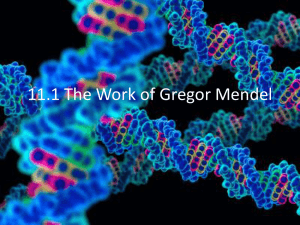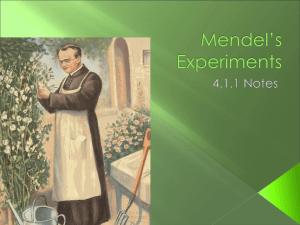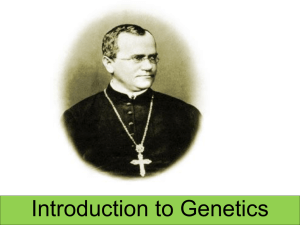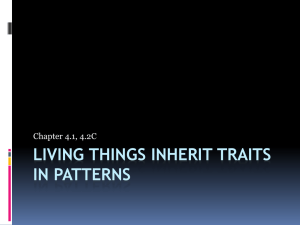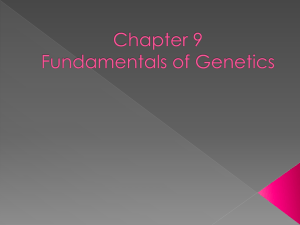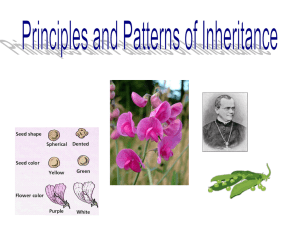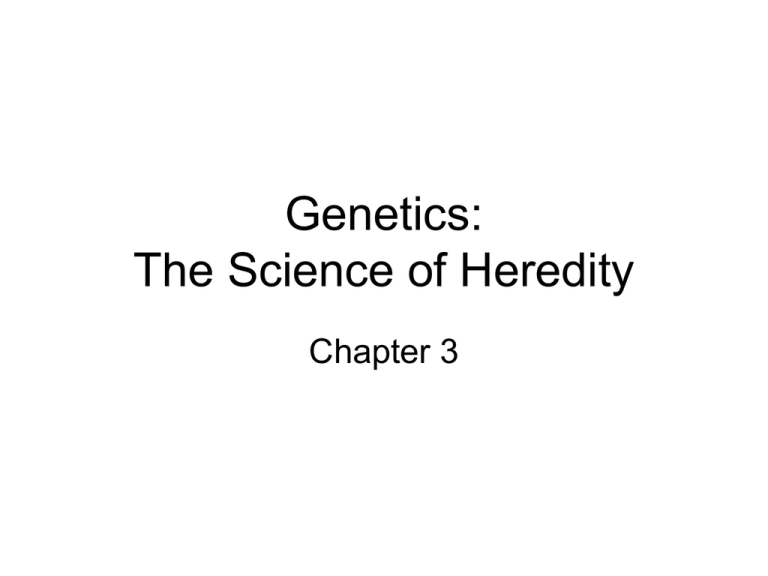
Genetics:
The Science of Heredity
Chapter 3
Section 1: Gregor Mendel
• A young priest from Europe, became
a teacher and cared for hundreds of
pea plants
• Became curious about why some of
the plants had different physical
characteristics, or traits
• He noticed that some plants were
short and some were tall
• He also noticed some had yellow
seeds while some had green seeds
Mendel continued
• Mendel observed that
some pea plants had
different traits that their
parents
• The passing of traits from
parents to offspring is
called heredity
• The study of heredity is
genetics
Mendel’s Peas
• Mendel chose pea plants to
study because many of their
traits exist in only two forms: for
example, height is either tall or
short, not medium
• Mendel developed a way to
cross-pollinate, or “cross” pea
plants
• He removed pollen from a flower
on one plant and brushed it on a
flower of a second plant
Mendel’s Experiments
• To study inheritance of traits,
Mendel decided to cross plants
with opposite forms of a trait…
• For example, he crossed tall
plants with short plants to see
what the offspring would be
• He always started his experiment
with purebred plants
• A purebred plant is one that
always produces offspring with
the same form of a trait as the
parent (purebred short peas
always produce short offspring)
First Experiment
• In his first experiment, Mendel crossed
purebred tall plants with purebred
short plants (“P generation”)
• He called the offspring of the “P
generation” the first filial, or the “F1
generation” (Filial means son in Latin)
• To his surprise, all of the F1 generation
plants were tall even though one of the
parents were short
Second Experiment
• Mendel let the F1 generation plants self-pollinate
• These offspring were known as the F2 generation
• Mendel was surprised to see the F2 generation were both tall and
short!
• This occurred even though all of the F1 parents were tall!
• Mendel discovered about ¾ of the plants were tall and ¼ were short
Other Traits
• Mendel also did experiments to check for:
Seed shape, seed color, seed coat color, pod shaped,
pod color, and flower position
Dominant and Recessive
Alleles
• Factors that control each
trait exist in pairs…one from
the female parent and one
from the male
• One factor in a pair can hide
the other factor
• In the F1 generation, the tall
factor hid the short factor
Alleles continued…
• Today, factors that control
traits are called genes
• Different forms of genes
are called alleles
• In Mendel’s work, each
pea plant inherits a
combination of two alleles
from its parents
– Either:
• Two alleles for tall stems
• Two alleles for short stems
• One of each
Alleles continued…
• Individual alleles control
the inheritance of traits
• Some alleles are
dominant
– A trait that always shows
up in the organism when
the allele is present
• Some alleles are
recessive
– These are masked, or
covered up, when the
dominant allele is present
– A trait controlled by a
recessive allele will only
show up if the organism
does not have the
dominant trait
Understanding Mendel’s Crosses
• Here is how Mendel’s results
work:
• The P generation tall plants
(purebred) had two alleles for
tall stems
• The purebred short plants had
two alleles for short stems
• The F1 generation received
one tall and one short allele
• The F1 plants are called
hybrids (they have different
alleles for the trait)
• All the F1 plants are tall
because the dominant allele
(tall) covers the recessive
allele (short)
Understanding Mendel’s Crosses
continued…
• When the F1 plants
(hybrids) were crossed
with each other, some
inherited two dominant
alleles (these became tall
plants)
• Some inherited one
dominant and one
recessive allele (these
were tall)
• Some inherited two
recessive alleles (these
were short!)
Symbols in Genetics
• Letters are used to represent
traits in today’s world
• A dominant allele is
represented by a capital letter
(T)
• A recessive allele is
represented by a lowercase
letter (t)
• TT would mean two dominant
alleles
• tt would mean two recessive
alleles
• Tt would mean one dominant
and one recessive allele
Mendel’s Contribution
• In 1900, three scientists
rediscovered Mendel’s
work
• Many of Mendel’s
discoveries are still used
today
• Because of his important
work, Gregor Mendel is
known as the “Father of
Genetics”
Section 2: Probability
• Probability is the
likelihood that a
particular event will
occur
• If you flip a coin… the
probability of landing
on heads is 50%, and
the probability of
landing on tails is
50%
Principles of Probability
• There are three ways to express
probability
• As a ratio: 1 to 2
• As a percent: 50%
• As a fraction ½
• The laws of probability predict what
MIGHT occur.
• If you flip a coin 10 times you might
get 5 heads and 5 tails, or you
might get 1 head and 9 tails…
Mendel and Probability
• Remember…when Mendel
crossed two hybrid plants (Tt),
¾ were tall and ¼ were short
• Mendel stated that the probability
of producing a tall plant was 3 in
4, and the probability of
producing a short plant was 1 in 4
• Mendel was the first scientist to
recognize that the principle of
probability can be used to predict
the results of genetic crosses
Punnett Squares
• A Punnett square is a chart
that shows possible
combinations of alleles that
can result from a genetic
cross
• They are also used to
determine the probability of
a particular outcome
• TT = 25%
• Tt = 50%
• tt = 25%
Phenotypes
• An organisms
phenotype is its
physical appearance
• Phenotypes are
visible traits
• An example:
Pea plants can have
one of two different
phenotypes for stem
height: tall or short
These are physical
characteristics of
something!
Genotypes
• A genotype is the genetic
makeup or the allele
combinations
• TT, Tt, tt
• An organism that has two
identical alleles for a trait
is homozygous (TT, tt)
• An organism with different
alleles for a trait is
heterozygous (Tt)
Codominance
• Sometimes, there is no
dominant or recessive
allele
• When this happens, the
offspring inherits both
alleles
• For example, if a
purebred black cow is
crossed with a purebred
white cow, the cow will be
both black and white.
Section 3:
Chromosomes and Inheritance
• In humans, each body cell
(skin, blood, liver, etc.) has 46
chromosomes (or 23 pairs)
• Sex cells (sperm and egg)
contain 12 chromosomes
• Walter Sutton, an American
geneticist discovered this
• He concluded that genes are
carried from parents to their
offspring on chromosomes.
• This is known as the
Chromosome Theory of
Inheritance
Meiosis
• Meiosis is the process by
which the number of
chromosomes is reduced
by half to form sex cells
(sperm and egg)
• During meiosis the
chromosome pairs
separate and are
distributed to two different
cells.
• The sex cells that are
created have only half as
many chromosomes as
the other cells in the
organism.
Chromosomes
• In body cells of
humans, there are 23
pairs (46 total)
chromosomes
• Chromosomes are
made of many genes
joined together like
beads on a string
• Each gene controls a
particular trait
Section 4: DNA Connection
• The main function of genes is to
control the production of proteins in
cells
• Proteins help to determine the size,
shape, and other traits
• DNA is a major component in
chromosomes
• A = Adenine
• T = Thymine
• G = Guanine
• C = Cytosine
• Remember, these four bases form the
“steps” of the DNA ladder
Making Proteins
• The order of the four nitrogen
bases (A, T, G, C) along each
gene forms a genetic code that
specifies what type of protein
will be produced
• The production of proteins is
called Protein Synthesis
• During this process, the cell
uses information from a gene
on a chromosome to produce a
specific protein
• Protein Synthesis takes place in
the ribosomes
The Role of•
RNA •
•
•
•
•
•
The ribosomes are found in the
cytoplasm
The chromosomes are in the
nucleus
How does the information needed
to make proteins get from the
nucleus to the ribosomes?
A “messenger” must first carry the
genetic code from the DNA (in the
nucleus) into the cytoplasm (to
the ribosomes)
The “messenger” is RNA
RNA looks like one side of the
“DNA ladder”
RNA also has four nitrogen
bases: adenine (A), guanine (G),
cytosine (C), and uracil (U)
Types of RNA
• There are two main
types of RNA
• Messenger RNA:
– Copies the coded
message from the
DNA in the nucleus,
and carries the
message to the
cytoplasm for the
ribosomes
• Transfer RNA:
– Carries amino acids
and adds them to
growing proteins
Protein Synthesis
• Step 1: mRNA Production
– In the nucleus, DNA “unzips” between
base pairs, and RNA bases match up
along the DNA strands…the genetic info
from DNA is transferred to the RNA
• Step 2: mRNA attaches to a
Ribosome
– mRNA enters cytoplasm, attaches to a
ribosome, production of protein begins
• Step 3: tRNA attaches to mRNA
– tRNA carries amino acids to the
ribosome, they match up with bases on
the mRNA, protein chain grows
• Step 4:Protein Production Complete
– Chain grows until the ribosome tells it to
stop…the chain is released and the
protein is complete
Mutations
• Any change that occurs in
a gene or chromosome is
called a mutation
• Mutations can cause a
cell to produce an
incorrect protein during
protein synthesis
• If this happens, an
organism’s phenotype
(traits) will be different
from what it should have
been
• If a mutation happens in a
body cell, only that cell is
affected
• If a mutation happens in a
sex cell, offspring can be
affected
Effects of Mutations
• Some mutations can
be harmful
– These mutations can
reduce an organism’s
chance of survival
• Some mutations can
be helpful
– These mutations can
improve an organism’s
chance of survival
• Some can be neither

